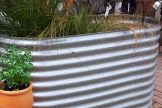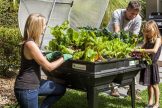
March is Luk or eel season in the local language. Particularly significant here in Bulleen due to the Bolin Bolin Billabong which was the site of large corroborees celebrating this sacred, spiritual protector. As the Eel travels downstream it wallows in the waters of the billabong to take on salt so that it is ready for its journey to the sea.
This is the season when the hot winds die down, the temperature starts to cool. That is the hope at least after such a consistently warm summer. Autumn – after the rain starts, is the best time to plant in Melbourne. The combination of warm soil, expected rainfall and lowering seasonal temperatures allows for good root development. This increases the time plants have to establish before the dry summer heat hits.
Harvest time continues in your vegie garden, but now is also the time to think about what you want to plant in winter. For those who have been asking, our autumn bulb range is starting to arrive, and garlic, traditionally planted around the autumn equinox (roughly March 21), is due early March.
Enjoy the stable cooler weather and await the coming of the rain.

Planting
The edge is off the summer sun and humidity and things are a lot more pleasant in the garden. Clean up the remains of your summer vegies if they are coming to the end of their useful life. These can be composted if you chop up the stalky parts first (a sharp spade is good) but avoid adding plant matter that might have been diseased, such as with powdery mildew. If you want to pull up your tomatoes but have still got lots waiting to mature, you can do both. Pull the plants out roots and all and hang them upside down in a shady spot outdoors. Gradually the tomatoes will mature AND you’ll have the garden space back again.
Add compost and manures to the soil which will be depleted after a productive summer season.
Citrus
We are changing the way we need to fertilise citrus. The advent of uncontrolled citrus gall wasp has meant we need to reduce the production of both soft new spring growth which is attacked by gall wasp, and soft new leaves in summer – which are highly vulnerable to attack by citrus leaf miner. So early autumn is now the time to prune and fertilise your citrus. Do any pruning, tidying up you need now, and give a good hearty feed with a citrus fertiliser, or any good balanced fertiliser. Citrus give a lot of fruit, and consequently need regular feeding.
March in your edible garden
How about trying a no-dig approach for your new season of vegetables. Remove your summer crop – especially if they are diseased. If they are healthy, you could cut the tops off and leave the roots in the ground. Add a layer of compost mixed with manure then a layer of straw mulch on top. Plant your new seedlings into the compost and manure and water in. If you have a lot of weeds, place a layer of plastic-free cardboard down between your existing soil and the compost layer. Over the next few months, the roots will push their way through the compost into the soil below. The soil below will be rich in microorganisms (not having been disturbed by tilling) which will benefit your growing plants.
If you want to get in early, plant your hearty winter vegetables such as brussels sprouts, cauliflower, cabbage, silverbeet, broccoli and beetroot. Try some asian greens for a tasty change. You’ll need to watch out for Cabbage White Butterfly flitting about your plants. They are liable to lay eggs amongst the seedlings. If you do see suspicious holes in the leaves, use enviro-friendly Dipel to eliminate the caterpillars. Dipel degrades in the sunlight – so spray in the evening for best results. For leafy greens exclusion netting works really well for cabbage white butterfly – but for other crops remember it will exclude bees and other pollinators.
If winter vegies are not your thing – plant a green manure crop instead. There is now a good body of evidence that shows active living roots in the soil keeps the fertility in the soil better than leaving it fallow.
Think ahead to brighten up the grey winter days and plant some colour for winter. Some winter / spring flowering annuals such as alyssum, pansies, polyanthus and cinerarias take about 8-12 weeks to flower so get them in for some lovely splashes of warmth before the cold sets in. If you’re keen on Iceland Poppies (those lovely paper-delicate flowers in gorgeous pastel colours) get those in soon too for a display in September. St Patrick’s Day (March 17th) is the traditional time to plant sweet pea seeds.
Edibles to plant in Melbourne in March.
Below is a list of edible gardening seeds and seedlings that can be planted in March. Please keep in mind that this list has been developed for Melbourne’s climate. Some of the plants indicated will be either right at the start or the end of their ideal planting season, click the links to the factsheets for more detailed planting information.
 – Seeds – Seeds – Seedlings – Seedlings
|
 – Tubers / Crowns – Tubers / Crowns – Companion Plants – Companion Plants
|
 – Prone to Cabbage Butterfly – Prone to Cabbage Butterfly
|
Angelica Alyssum    Beetroot   Borage   Broad Beans  Broccoli    Broccoletti    Broccolini    Brussels Sprouts    Cabbage    Cardamom Leaf  Carrot   Cauliflower   Celery   Chamomile    Chervil  Chives    Coriander    Cress   Curry Plant  Echinacea   
|
Endive  Feverfew   Good Bug Mix   Green Manure  Kale    Kohl Rabi   Leeks   Lemon Balm  Lettuce   Licorice Herb  Lovage  Marjoram  Mint  Mizuna   Mustard   Nasturtiums   Pak Choy / Bok Choy   Parsley   Parsnip  Radicchio  
|
Radish  Rhubarb  Rocket / Arugula   Rosemary  Saffron Crocus  (or bulbs) (or bulbs)Sage  Salad Burnett   Savory   Silverbeet   Snow Peas   Sorrel   Spinach   Spring Onion   Tarragon  Tatsoi   Turnip  Warrigal Greens  Wasabi  Watercress  
|
Bulbs could be called “buried treasures”. You’re planting on a promise, but once those shoots appear and flowering begins it inspires even the most jaded of gardeners. Bulleen Art & Garden stocks a wide range of bulbs, both loose and packaged, so you need only buy exactly what you want. Late winter and early spring flowering bulbs such as jonquils and daffodils should be planted this month to ensure colour through the grey winter months.

The bulbs which need cooling to get them going, such as tulips and hyacinths, can be placed in the crisper of your fridge (not freezer) in a paper bag for 4-6 weeks before planting. For more information on bulbs & perennials click here.
Pruning
Take plenty of cuttings from your geraniums, azaleas, hibiscus, fuchsia, grevillea, camellias, lavender and rhododendrons. Take semi-hardwood cuttings (10cm pieces of new growth which has hardened off). This is a low cost way to fill up patches in your garden and the excess can be given away to friends and family. Cut back summer flowering plants that have finished blooming. You want to avoid the plant putting energy into seed production instead of growth. This is especially important with the plants which have weed potential, such as agapanthus. Left to seed, these plants will quickly invade surrounding areas. Even seed washed away has the potential to take root many kilometres away from your garden. Trim roses to encourage an autumn flush of flowers. Water in some plant food and more roses should appear before too long.
Slugs and Snails
Autumn rains bring out snails and slugs in full force. Sprinkle bait around newly planted seedlings and shrubs where snails and slugs breed. Large fleshy leaved plants are common hiding spots. Try animal safe snail baits or go looking for them at night, especially after rain.





